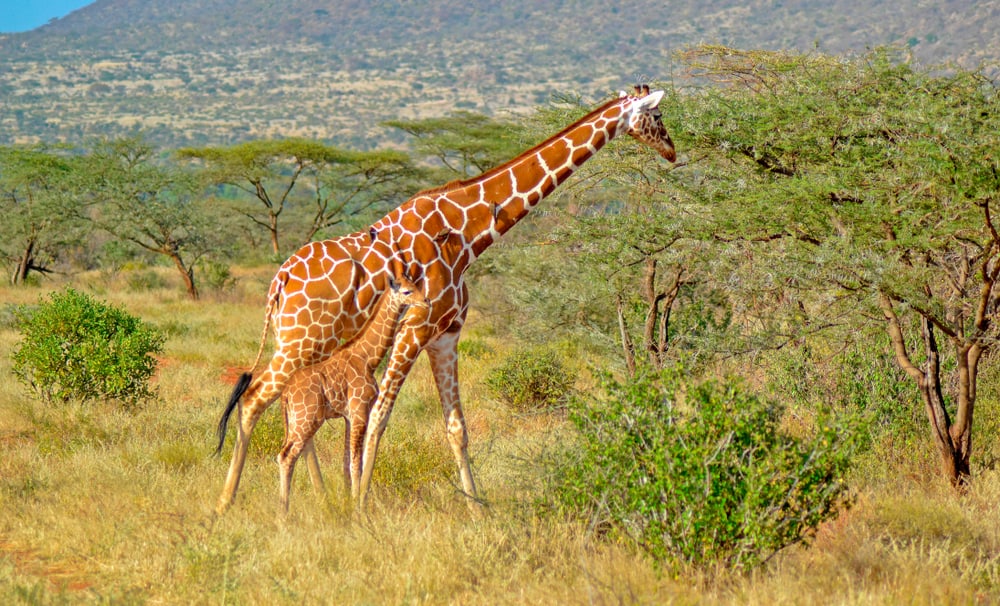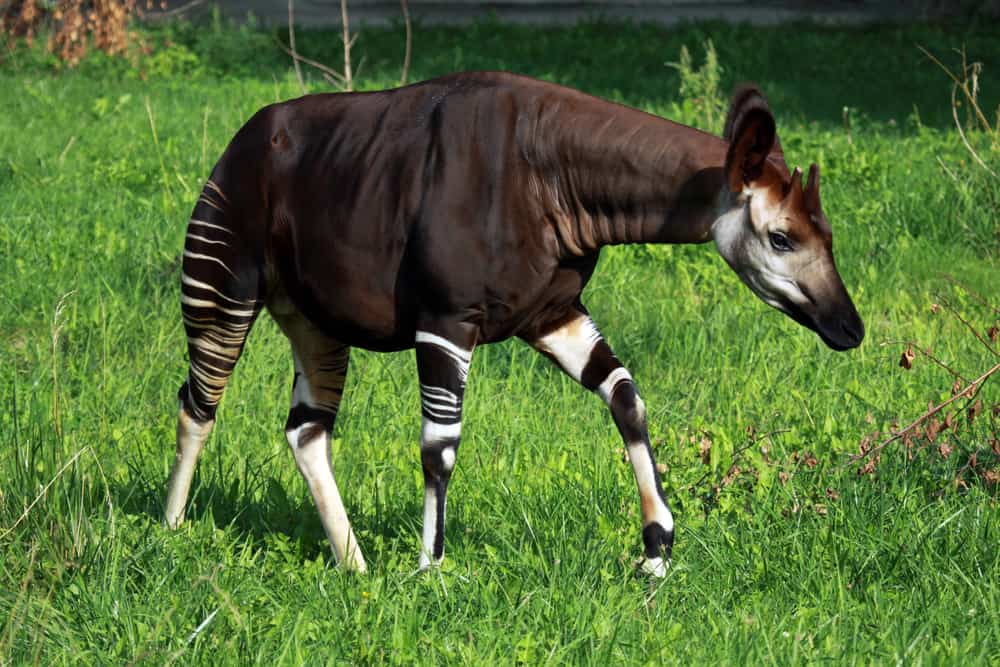The Giraffidae family is a group of large, hoofed mammals that are native to Africa. This family includes two living species: the giraffe and the okapi, both of which are iconic animals known for their unique physical features and behaviors.
Giraffes are recognized by their long necks, spotted coats, and towering height – they are the tallest land animal in the world.
Okapis, on the other hand, have shorter necks and legs but share some striking similarities with their distant relatives, including elongated tongues used to reach leaves high above ground level.
In this article, we will delve deeper into the fascinating world of Giraffidae, exploring their taxonomy, anatomy, behavior patterns as well as conservation efforts aimed at protecting these majestic creatures from extinction.
Genus
- Genus Giraffa – giraffes
- Genus Okapia – okapi

Taxonomy Of Giraffidae
The majestic giraffes have fascinated humans for centuries, with their long and graceful necks that tower over the African savannah.
These herbivorous mammals belong to the family Giraffidae, which includes two extant species – the northern giraffe (Giraffa camelopardalis) and the southern giraffe (Giraffa giraffa).
The evolutionary history of this family can be traced back to the Miocene epoch, about 20 million years ago when they first appeared in Africa.
The genetic diversity within Giraffidae is relatively low compared to other mammalian families due to a complex pattern of speciation events.
However, recent studies using molecular markers suggest that there may be more than four distinct lineages representing different species within Giraffidae.
Further research on these magnificent creatures will undoubtedly reveal more insight into their fascinating evolution and biology.
| Common Name | Scientific Name | Distribution |
|---|---|---|
| Northern Giraffe | Giraffa camelopardalis | Chad, Cameroon, Central African Republic, Democratic Republic of Congo, Ethiopia, Kenya, South Sudan, Sudan, Uganda |
| – Kordofan Giraffe | Giraffa camelopardalis antiquorum | Central and Western Africa |
| – Nubian Giraffe | Giraffa camelopardalis camelopardalis | South Sudan, Ethiopia, Kenya |
| – West African Giraffe | Giraffa camelopardalis peralta | Niger |
| Southern Giraffe | Giraffa giraffa | Angola, Botswana, Mozambique, Namibia, South Africa, Zambia, Zimbabwe |
| – Angolan Giraffe | Giraffa giraffa angolensis | Angola, Namibia |
| – Cape Giraffe | Giraffa giraffa giraffa | South Africa, Namibia, Botswana |
| – South African Giraffe | Giraffa giraffa giraffa | South Africa, Namibia |
| – Thornicroft’s Giraffe | Giraffa giraffa thornicrofti | Zambia |
Okapi | Okapia johnstoni | Democratic Republic of Congo |
Anatomy Of Giraffes And Okapis
Having discussed the taxonomy of Giraffidae, it is important to delve into their anatomy.
The giraffe and the okapi are the only surviving members of this family. These two species share some common characteristics such as long necks, ossicones (horn-like structures), and unique spots on their skin. However, they differ in various aspects including size, body shape, coat coloration, and habitat.
Giraffes evolved over millions of years from ancestors with shorter necks that roamed Africa about 20 million years ago. During this time period, they went through several evolutionary changes until they became what we know today as one of the tallest mammals on Earth.
In contrast to giraffes’ preferred habitats in savannas and grasslands across sub-Saharan Africa, Okapis inhabit dense rainforests in Central Africa. This is because these animals have adapted to live in areas where vegetation is abundant due to high rainfall levels throughout the year.
Furthermore, unlike giraffes which can reach up to six meters tall at full adulthood weight at around 1 tonne, adult okapis weigh between 200-300 kg and stand up to two meters tall at shoulder height.
Unique Physical Features Of Giraffes
Giraffes are known for their unique physical features, particularly their long necks. The average height of a giraffe is about 18 feet tall, with males being taller than females. This makes them the tallest mammals in the world and provides an advantage when it comes to reaching high branches for food.
The evolutionary history of giraffes has been studied extensively by researchers, and it has been found that they have adapted over time to suit their environment. For instance, the lengthening of their necks occurred as a result of competition for food in trees. Over time, giraffes evolved longer legs and necks so that they could reach vegetation up to six meters off the ground.
Additionally, giraffes have special valves in their arteries which prevent blood from rushing to their brain when they lower their heads to drink water or eat grass. These adaptations make giraffes well-suited for living on the African savanna where resources can be scarce at times.
Behavior Patterns Of Giraffidae
Giraffidae, a family that includes giraffes and okapis, have unique behavior patterns. Social interactions among giraffidae are mainly based on gender and age.
Female giraffes form groups with their offspring while male giraffes prefer to be solitary or in bachelor herds until they reach sexual maturity at around four years old. However, adult males may sometimes join female groups during mating season.
Feeding habits also play an important role in the behavior of giraffidae. They spend most of their day browsing on leaves from trees using their long necks to reach high branches. Due to this feeding habit, competition for food can lead to aggressive encounters between individuals. In such situations, dominant individuals will use headbutts as a means to establish dominance within the group.
The sight of two male giraffes engaged in combat over a mate is both thrilling and awe-inspiring.
Witnessing young calves frolicking together brings about feelings of joy and innocence.
Observing large herds of giraffes grazing peacefully under the African sun conjures up images of harmony and tranquility amidst nature’s beauty.
As experts/specialists in studying these majestic creatures, we continue to learn more about their complex social behaviors and how they interact with each other in the wild. Through our research, we gain insight into how giraffidae have adapted to survive in their natural habitat and what steps can be taken towards conserving their populations for future generations to appreciate and admire.
Conservation Efforts For Giraffes And Okapis
As a specialist in giraffidae, it is evident that both giraffes and okapis face numerous threats to their survival. One of the most significant challenges these animals encounter is habitat loss due to human encroachment on natural ecosystems. For instance, population growth has led to deforestation, which directly affects the availability of food for these herbivorous mammals. Additionally, climate change poses a severe threat as changes in temperature and rainfall patterns affect vegetation growth cycles.
To mitigate this problem, community involvement and habitat restoration efforts can be implemented. Community participation in conservation activities such as tree planting initiatives could help restore depleted habitats for giraffe populations. Moreover, working with local communities helps create awareness about the importance of preserving wildlife and reducing negative impacts on ecosystems. In addition, Habitat restoration programs may include ecotourism projects designed to promote economic benefits from wildlife tourism while also safeguarding biodiverse areas.
| Threats | Conservation Efforts |
|---|---|
| Habitat Loss | Community Involvement |
| Climate Change | Habitat Restoration |
| Poaching | Ecotourism |
| Mining Activities | Research Studies |
| Human-Wildlife Conflicts | Public Awareness Campaigns |
Efforts towards conserving giraffes and okapis must continue because they play an essential role in maintaining healthy ecosystems by promoting biodiversity through seed dispersal, pruning trees, and fertilizing soil. Therefore we need to work together to preserve their habitats and ensure that future generations get to enjoy seeing these magnificent creatures roaming freely in their natural settings.

Threats To The Survival Of Giraffidae
Giraffidae, like many other wild animals are facing numerous threats to their survival. One of the biggest challenges is habitat loss due to human activities such as deforestation and land-use changes. These practices have led to a significant reduction in the available habitats for giraffes leading to their displacement from their natural ecologies.
Another critical threat that Giraffidae faces is poaching pressure. Poachers hunt these gentle giants for various reasons, including meat, hides, and trophies. The demand for bushmeat has also contributed significantly to the decline in giraffe populations across Africa. Additionally, cultural beliefs associated with some communities contribute immensely to the prevalence of illegal hunting activities targeting Giraffidae. Therefore measures should be taken by governments and concerned organizations aimed at reducing poaching pressures on this magnificent animal species through sensitization campaigns and enforcement of anti-poaching laws.
Four factors contributing to threats faced by Giraffidae include:
- Climate change which alters food sources and water availability.
- Habitat fragmentation resulting in isolated populations.
- Human-wildlife conflict arising from competition over resources.
- Loss of genetic diversity within population clusters.
It’s essential that all stakeholders come together towards finding sustainable solutions that can help secure the future of these beautiful animals threatened with extinction if we do not act soon enough!
Conclusion
Giraffidae is a family of mammals that includes giraffes and okapis, both with unique physical features that distinguish them from other animals.
Giraffes are the tallest living land mammal, reaching up to 18 feet in height, while okapis have stripes on their legs similar to zebras but resemble giraffes in terms of neck length and tongue shape. These species exhibit different behavior patterns such as sociality and territoriality.
Conservation efforts for both giraffes and okapis are underway due to declining populations caused by habitat loss, poaching, and climate change. The International Union for Conservation of Nature (IUCN) estimates that there are only around 111,000 giraffes left in the wild, making them vulnerable to extinction. Similarly, the population of okapis has declined by more than 50% over the past two decades according to the World Wildlife Fund (WWF).
It is important to note that despite being iconic figures in popular culture and tourism industries worldwide, these beautiful creatures face numerous threats which require urgent action by governments and conservation organizations alike.
With concerted efforts towards sustainable development practices and protection of wildlife habitats globally, we can ensure a future where giraffidae continues to thrive alongside other species.
As a specialist in this field, I urge everyone to support initiatives aimed at preserving these magnificent animals who play an integral role in maintaining ecosystem balance across various regions worldwide.

